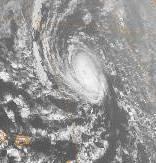Formed December 12, 1984 Fatalities None reported Highest winds 129 km/h | Dissipated December 24, 1984 Damage Minimal Affected areas Puerto Rico, Hispaniola | |
 | ||
Lowest pressure 980 mbar (hPa); 28.94 inHg Areas affected Puerto Rico, Hispaniola Date 12 December 1984 – 24 December 1984 Similar Hurricane Alma, Subtropical Storm Alpha, Tropical Storm Arlene, Tropical Storm Odette, Hurricane Klaus | ||
Hurricane Lili was one of only five Atlantic tropical cyclones on record to reach hurricane status in the month of December. The final of thirteen tropical storms in the 1984 Atlantic hurricane season, Lili developed as a subtropical cyclone which originated from a frontal trough to the south of Bermuda on December 12. It tracked southeastward, then northward, slowly attaining tropical characteristics and becoming a hurricane on December 20. Lili turned to the south and southwest, briefly threatening the northern Caribbean islands before weakening and dissipating near the coast of the Dominican Republic. The storm produced light rainfall but no damage.
Contents
Meteorological history
In the second week of December, a frontal trough stalled south of Bermuda. An upper level disturbance moved over the area on December 9, and produced widespread convection along the frontal wave. The system moved to the northeast, and based on a developing circulation within the convection, the National Hurricane Center classified the system as a subtropical storm on December 12 while located 275 miles (440 km) northeast of Bermuda.
With winds of 60 mph (95 km/h) and strengthening, the subtropical storm initially drifted northeastward. On December 13, a ridge of high pressure to its north forced the storm southeastward, and the following day the storm turned to the south after an upper-level cold-core low developed over the system. A break in the ridge resulted in the storm turning to the northeast, with its forward motion accelerating to nearly 40 mph (65 km/h). After turning to the northwest on December 17, the high pressure system again halted its northward movement, leaving the storm drifting south-southeastward. Conditions favored further strengthening, and the subtropical storm reached 70 mph (115 km/h) winds on December 18. Satellite imagery estimated the storm attained hurricane status on December 19, and a day later ship near the center reported winds of 75 mph (120 km/h). Based on the wind report, as well as a minimum central pressure of 980 mbar and a well-defined eye, the storm was classified as Hurricane Lili while located 730 miles (1,180 km) east of Bermuda.
Lili continued generally southward, reaching its peak intensity of 80 mph (130 km/h). Higher pressures developed to its northeast, resulting in the hurricane to accelerate to the southwest. On December 22, Lili finished executing its large cyclonic loop by passing over the same location it passed one week prior. The combination of its increased forward speed, as well as increased levels of vertical wind shear, created an unfavorable environment which caused steady weakening. On December 23, Lili weakened to a tropical storm while located 430 miles (690 km) northeast of Antigua. It rapidly lost organization as it approached the Leeward Islands, and dissipated just off the coast of the Dominican Republic on December 24.
Impact and records
When Lili reached hurricane status on December 20, it became one of only four Atlantic tropical cyclones to reach hurricane strength in the month of December. The other three were an unnamed hurricane in the 1887 season, Hurricane Alice in 1954, and Hurricane Epsilon in 2005. In addition, Hurricane Nicole lasted as a hurricane from late November to early December 1998.
Because of its rapid movement, a hurricane watch was issued for Puerto Rico and the Virgin Islands on December 22. As the storm weakened, the watches were discontinued. In response to the threat of the hurricane, officials posted a small craft advisory along the coastline of northern Puerto Rico. There, the weakening tropical cyclone produced light rainfall, though there was no reported damage. Lili moved through Hispaniola as an area of squally weather, but damage, if any, is unknown.
